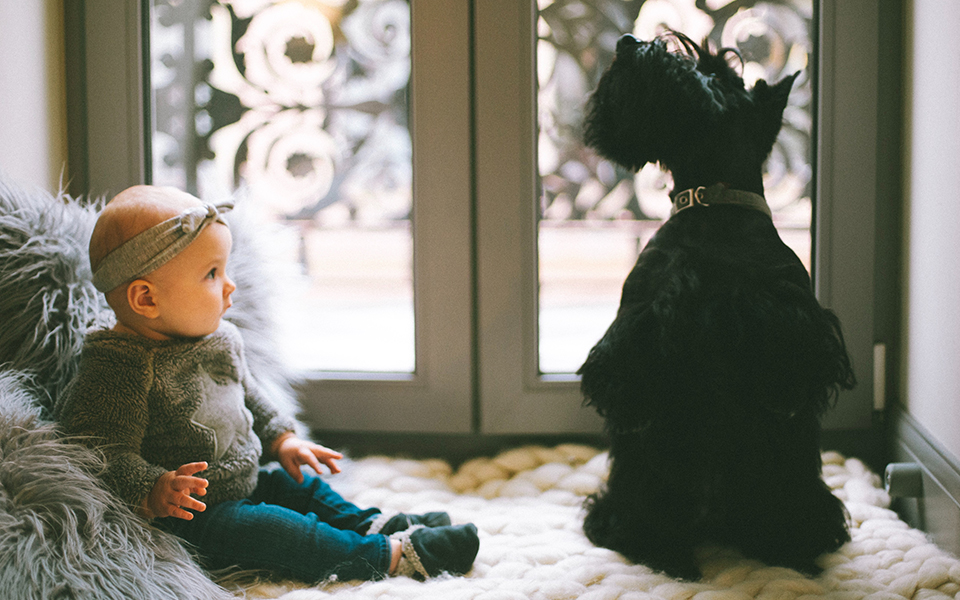One of my best experiences as a professional dog trainer was watching my daughters grow up with my dog. There were some significant transitional milestones that I needed to guide my dog through during this journey. I wanted to share them with your family so your dog can be ready for them.
Month 1-3
The infant stage is when your dog will be curious about that new bundle you are always carrying around. Showing some curiosity and interest is healthy and should be encouraged. Allowing your dog to lick the baby’s face or jump onto the baby is not ok. Remember, your newborn is very fragile and vulnerable. As the mama, you’re just learning how and when to feed your newborn, discovering how to help them sleep, and tending to your baby’s every constant need. Your dog is also adjusting to the continuous action around the house. The dog is trying to acclimate to your changing schedules and may even be restless and always following you around the house. With everybody celebrating such a special time, an above-average number of family or friends are coming by to see the baby or help you. This might cause over-excitement for the dog, and we don’t want to start isolating the dog to get control. Reliable obedience training is going to come in handy during this time. You are now spending lots of time caring for your baby’s needs: feedings, constant sleeping, a clean bottom, and lots of bonding. We must remember that our dog is now getting used to sharing some of that attention.
From a safety standpoint, a newborn doesn’t always look like a human at first (sorry, mamas, even though we think they are the cutest thing to hit the planet). Your dog is trying to figure out what this thing is with the flat face and cone-shaped head. Because your dog might not perceive your newborn as a human, you need to factor in the danger of predatory drive. Statistically, this is the most dangerous time for an attack on your baby while they are sleeping in a bassinet, crib, or even a swing. Babies have something called a Moro reflex. This reaction is when your baby has a jumpy response when startled. When combined with an infant scream, your dog could perceive your newborn as prey rather than a human. I know this is very scary, and it should be. That is why your dog mustn’t have access to the baby nursery or anywhere a baby could be sleeping in a bassinet, crib, or swing. Incorporating baby gates into your home can help with separation during these times. The good news is that your newborn needs 14-17 hours of sleep daily, so there is plenty of time for your dog to have time with you.
The other safety precaution is desensitizing your dog to baby cries. Newborns cry, and they are supposed to because that is how they tell us they need something. As you figure out your baby’s different cries and meanings, your dog is also getting used to the noise. I just read a study that said 80-90% of babies once a day have a crying burst from 15 minutes to an hour. I used to refer to this as my baby’s “witching hour!” It was nerve-wracking, to say the least because you are trying anything you can to soothe your little one. Dogs pick up on our stress, and it can also make them anxious. I used to have high-drive bones and chews for that time. My daughter would have these spells in the early evening, and my dog would come over to me to get his bone.
This is a challenging few months for our changing hormones. Dogs are in tune with every emotion; when we are tired, crying (for a reason we couldn’t explain), and overwhelmed, our dogs sense these constant changes. Hire a dog walker, have a family member take the dog out for exercise, and provide outlets for your dog to help them through this time. Soon, you will be itching to get the dog out on stroller walks with your little one.
Month 4-7
People keep saying it will get more natural, and in some ways, it has (at least for the dog). You’ve settled into a routine; even the chaos is still the norm, according to your dog! Your baby can do more, such as raise arms, be propped up against things, and maybe even enjoy those tummy time sessions. Your dog is expected to share its most important domain, the floor, with the baby. Baby toys are spread around the house, and we must teach the dog the difference between their toy and the baby. I like to use a toy box for dogs only and keep it in the same room. Throw some treats in it daily so that the dog “checks” and finds rewards. Eventually, your baby will start rolling over and squirming around more. The dog does not perceive your baby as a threat because the dog can quickly get up and move away from the baby. If your dog is always trying to hog the baby’s space, then this is where you can use your “Away” command. The dog needs to respect you and the baby’s time together. The baby and dog are not in competition, nor are they equals.
Somewhere in this time starts the most rewarding period for your dog: introducing baby food! How awesome is it that this baby always smells like food, and if your dog is lucky, drops plenty of it under their highchair? At first, I would ban my dog from the kitchen, but after cleaning the floor multiple times a day, I gave in. If you have a dog that is not a food resource guarder, then have at it. It is not worth it if your dog has any issues with food, bones, or toys. Keep the dog separate during baby feedings and snacks, as it is unsafe and will only create more issues.
From a safety standpoint, this is when we need to start preparing your dog for when your baby will begin making grasping attempts. This skill perfects rather quickly, and your baby could grab ahold of the dog’s fur, ears, or tail and startle the dog. I prepared my dog by randomly making similar pulls and pinches while petting him. Practicing this is another form of desensitizing the dog. You’re not trying to hurt your dog to see their reaction; you want to ensure that if they do startle, their first reaction is not to snap at us. This period is also when the baby wants to touch and taste anything they can get their hands on, including dog food, toys, and water bowls. Now that the baby is more interactive and entertaining, this helps your dog to know that it is a tiny human.
Month 7-9
This baby is now on the move, regularly eating and hopefully sleeping! Most babies are crawling, scooting, or moving to get to things. Nothing is safe anymore! This stage is another caution time between dog and baby. Most babies find dogs stimulating and could stress the dog by constantly crawling over to their dog bed, food/water bowls, and toys. It is critical that your dog has downtime away from your baby or has somewhere to go to leave the baby and not feel trapped. Up to this point, your dog has tolerated the baby because they were never a threat. We want the dog to continue positively associating with your baby. Activities such as stroller walk together and relaxed petting with the baby on your lap so you can intervene if the baby tries to pinch or yank at the dog. The goal is to establish an environment where the baby and the dog are together in a calm, controlled way.
From a safety standpoint, do not allow your baby to interact with your dog while eating or drinking. These are resources for the dog and can create conflict. Your dog could tolerate this in the beginning, and it could give a false assumption that your dog will not nip the baby in the future. Please take this time to continue to observe your dog’s body language around the baby. Do they keep trying to get away from the baby? Have they growled at any point around the baby? Have they shown any avoidance or displacement behaviors? If you answered yes to any of these, you must start managing the dog accordingly. Those are red flags for the next stage of the baby’s development.
Month 9-12
This stage is when my baby girl was so clumsy! She would pull herself on anything she leaned against and then fall back on her butt and later try it over and over again. Eventually, she got sturdy on her legs and then would hurry across all the furniture. All this action can be challenging for the dog for a few reasons. First, the baby appears more unpredictable with their movements. Second, the baby is now at the eyesight level with the dog. Some dogs can be perceived as a threat. Lastly, it is all about discovery for the baby, and the entire house and its contents are fair game. A few other behaviors arise in the babies, such as pulling their hair, banging their heads, rocking motion, and grinding their teeth. Studies can’t determine the cause of these unexpected behaviors other than it could be a way for the baby to release anxiety or stress. The baby also goes through a fear period during this time, even of things that they have seen in the past. As the mom, we alternate between moving objects, taking things out of the baby’s mouth, and exchanging activities. For your dog, it can be even more stressful. Dogs like to predict events. Some dogs also want to control environments and decide if this child needs to be controlled (typical dog logic). If you have a reactive dog, a timid/fearful dog, or an older dog, this could be an issue for your evolving family.
From a safety standpoint, we as moms must keep the environment safe for the baby and the dog. Please don’t wait until there is an incident because it is too late. Dogs warn us with their body language of how they are adapting. Just because your dog might be stressed or uncomfortable around the baby doesn’t mean something is wrong with them. It just means that for the time being, we need to manage them accordingly for your baby’s safety.
Thank you for allowing Dogs to Diapers and my experience to be part of your journey. Enjoy that growing baby, and congratulations; it has been a year, and hopefully, your new baby and dog have started to develop a beautiful bond.
If you are early in your pregnancy journey, preparing your dog for the upcoming changes when bringing home a newborn is the best approach for a smooth transition.
From my family to yours,
Carrie Silva Wooddell, Owner of Dogs to Diapers and The Doghouse, LLC



